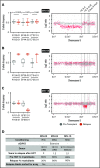Recurrent genetic HLA loss in AML relapsed after matched unrelated allogeneic hematopoietic cell transplantation
- PMID: 31324640
- PMCID: PMC6650729
- DOI: 10.1182/bloodadvances.2019000445
Recurrent genetic HLA loss in AML relapsed after matched unrelated allogeneic hematopoietic cell transplantation
Abstract
Immune evasion is a hallmark of cancer and a central mechanism underlying acquired resistance to immune therapy. In allogeneic hematopoietic cell transplantation (alloHCT), late relapses can arise after prolonged alloreactive T-cell control, but the molecular mechanisms of immune escape remain unclear. To identify mechanisms of immune evasion, we performed a genetic analysis of serial samples from 25 patients with myeloid malignancies who relapsed ≥1 year after alloHCT. Using targeted sequencing and microarray analysis to determine HLA allele-specific copy number, we identified copy-neutral loss of heterozygosity events and focal deletions spanning class 1 HLA genes in 2 of 12 recipients of matched unrelated-donor HCT and in 1 of 4 recipients of mismatched unrelated-donor HCT. Relapsed clones, although highly related to their antecedent pretransplantation malignancies, frequently acquired additional mutations in transcription factors and mitogenic signaling genes. Previously, the study of relapse after haploidentical HCT established the paradigm of immune evasion via loss of mismatched HLA. Here, in the context of matched unrelated-donor HCT, HLA loss provides genetic evidence that allogeneic immune recognition may be mediated by minor histocompatibility antigens and suggests opportunities for novel immunologic approaches for relapse prevention.
© 2019 by The American Society of Hematology.
Conflict of interest statement
Conflict-of-interest disclosure: J.R. reports research funding from Equillium and Kite Pharma and consulting income from Aleta Biotherapeutics, Avrobio, Celgene, Draper Labs, LifeVault Bio, and TScan Therapeutics. R.J.S. reports participation in the data and safety monitoring board of Juno/Celgene and the board of directors of Kiadis and National Marrow Donor Program/Be The Match and consulting income from Gilead, Merck, and Astellas. J.K. reports consulting income from Amgen, Fortress Biotech, Cugene, and Equilium and research support from Miltenyi Biotec GmbH, Prometheus Labs, and Bristol-Myers Squibb. A.R.T. reports consulting income from AlphaSights. R.C.L. reports consulting income from Takeda and research support from Jazz and MedImmune. B.L.E. reports funding from Celgene and Deerfield. W.J.L. reports income and participation on the scientific advisory board of CareDx. The remaining authors declare no competing financial interests.
Figures



References
-
- Vago L, Perna SK, Zanussi M, et al. . Loss of mismatched HLA in leukemia after stem-cell transplantation. N Engl J Med. 2009;361(5):478-488. - PubMed
-
- Spierings E. Minor histocompatibility antigens: past, present, and future. Tissue Antigens. 2014;84(4):374-360. - PubMed
-
- Kataoka K, Nagata Y, Kitanaka A, et al. . Integrated molecular analysis of adult T cell leukemia/lymphoma. Nat Genet. 2015;47(11):1304-1315. - PubMed
Publication types
MeSH terms
Substances
Grants and funding
LinkOut - more resources
Full Text Sources
Other Literature Sources
Medical
Research Materials

